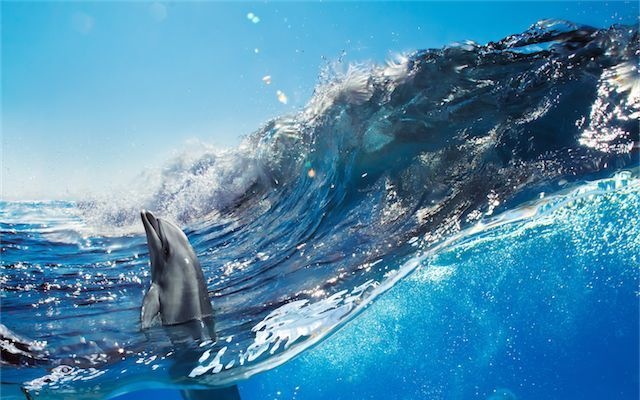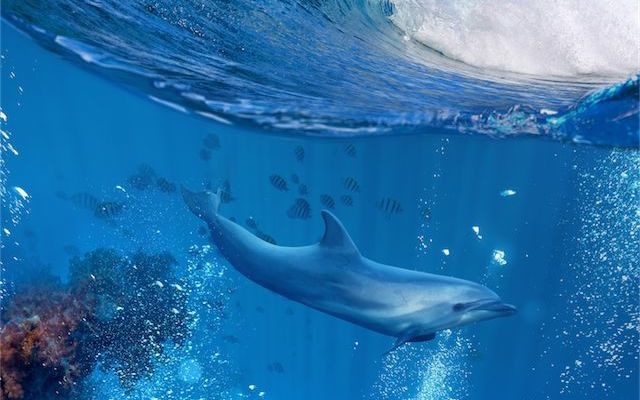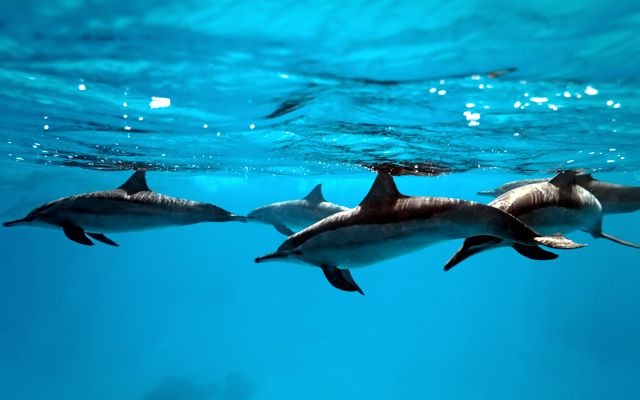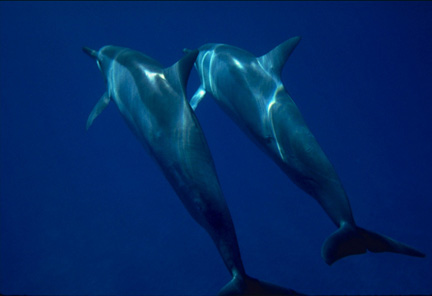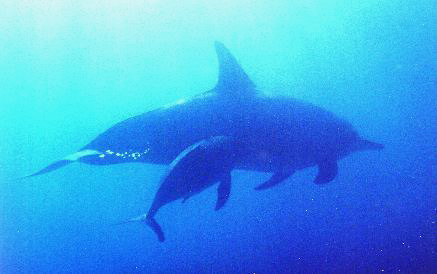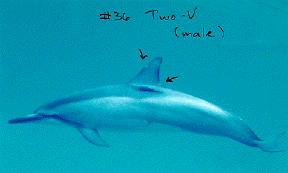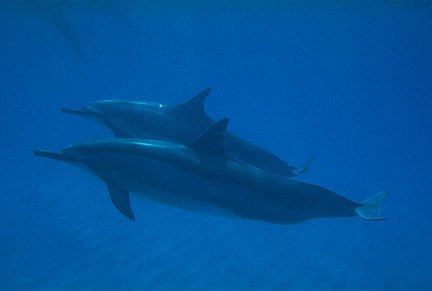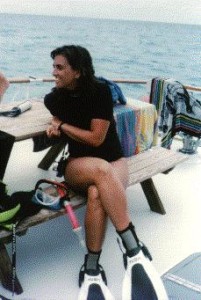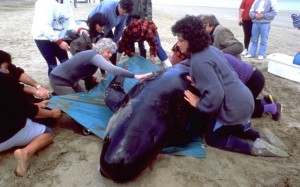ET Wild Dolphin Programs
We’re privileged to share our world with other self-aware, caring beings: the aboriginal people of the sea.
The Spinner Study – Wild Dolphin Identification and Protection
An EarthTrust Science and Conservation Effort
To Study and Protect Hawaiian Spinner Dolphins
Initiated in 1995 (and now in “pause” mode), the Spinner Study has been a long-term science and conservation study monitoring the habits and populations of the societies of wild spinner dolphins, Stenella longirostris, that swim in the shallow coastal waters around the Hawaiian islands. Earthtrust is has conducted this study of wild dolphin behavior with the aim of establishing their important habitats, social structures, and longevity. This research has enriched our knowledge of dolphin behavior and heighten awareness of the ways humans impact it. We hope to continue and expand it as funding allows.
Conservation in a larger sense is also served by increasing our knowledge of spinner dolphins. Spinners are one of the two major species which have died by the millions in the tuna purse seine nets. Most people are unaware that Congress has legalized importing tuna caught by killing dolphins. There is no question that the tuna-porpoise slaughter, in terms of numbers killed, is one of the most pressing dangers to cetaceans today.
Are Humans Harmful?
The interaction of humans with wild dolphins is a special gift – one that should be valued and protected. The current trend towards environmental awareness is accompanied by people seeking ways to change their relationship with nature. In Hawaii this has been demonstrated in recent years by the increasing numbers of people who have discovered the accessibility of the exuberant Hawaiian spinner dolphins, and avidly pursue trying to swim with them. As this type of “ecotourism” becomes more popular, it may become critical to the welfare of these dolphins to define guidelines for appropriate behavior for humans seeking to observe dolphin life. Earthtrust’s research constitutes the baseline scientific study necessary to evaluate impacts like this and others on the dolphins, and to secure protection for them if and when they need it.
Getting To Know You
Scientific data is critical and necessary for conservation. In order to best determine how to manage these animals, we must understand their way of life and their needs. We need to know as much as we can about who they are and what their lives are like.
The birth of this baby was an exciting event for us, as we have known the mother, Heart, for three years, and were looking forward to following the growth of her offspring. Sadly, the baby disappeared within two weeks of taking this photo. Heart was seen in the spring of 1998, looking full in the belly, and we have hopes that she has given birth to a healthy new baby.
Our work has focused on a group of spinner dolphins off the coast of Oahu. These dolphins forage for food in the deep ocean at night but rest in shallow coastal waters during the day, making it easy for us to unobtrusively observe them. Identification of the dolphins, which enables us to build an accurate profile of their population, is a critical component of the study, and is achieved through underwater photography and video. Slides and video data are analyzed for identity and then catalogued and archived. IDs are determined primarily by using distinct scars and coloration patterns on the dolphins’ bodies. Data is recorded on the dates each animal is seen, as well as any dolphin associations observed. Each “new” dolphin is compared against the extensive ID collection (to date over 2000 slides of over 130 dolphins, out of an estimated 200 to 300 near the study site).
Example of Photo ID being utilized to identify individual dolphins. Characteristic scars–such as the “V” notches in this dolphin’s dorsal fin, are permanent “fingerprints” of individual dolphins.
The Spinner Study also seeks to explore the concepts of long-term site fidelity as well as whether there is any inter-island migration of the spinners. It is not known whether the Hawaiian spinners travel to other islands. There has been extensive research on spinner dolphins on the Big Island of Hawaii, and to an extent on the spinners near the island of Lanai. In 1997 we began a photo ID archive of spinners on the northeast coast of Kauai. By comparing our data with that of researchers from other islands, we may be able to answer this question.
In 1995 we analyzed a collection of ID slides of Oahu spinners, taken by researcher Ed Shallenburger in 1978 – and we instantly recognized one of our “regulars,” Double Decker. Named because of two unmistakable chunks missing from his dorsal fin, and pictured here in the foreground, Double Decker is a large adult male who frequently visits the research area – and because of the Spinner Study we now have proof he was doing so for at least 20 years.
Spinners On TV
Unique underwater video footage we obtained during the summer 1997 field season was used extensively in an award-winning documentary which appeared on the Discovery Channel in March, 1998. “Ocean Acrobats: The Spinner Dolphin” featured interviews with EarthTrust researchers Suchi Psarakos and Dr. Ken Marten, and highlighted the important work they are doing with the spinners in Hawaii.
Shore-Based Data Collection
EarthTrust’s research also measures aspects of the spinners’ behavior, such as their apparent preference for special swimming and rest areas. During peak tourist months of 1995, 1996, and 1997, an intensive daily observation period was conducted. Collecting this data is critical for determining whether the dolphins’ use of these bays is being adversely affected by humans. Both swimmers and dolphins were observed and pertinent data on the behavior of each was noted and recorded. The data set included such parameters as the number and location of dolphins and swimmers, and number of seconds between a given dolphin surfacing for air, as well as number of spins, leaps, and slaps on the surface that the dolphins made. Aerial behavior, so magnificent in spinners, is a good general indicator of behavior level. Organization and analysis of this large and complex data set is underway, and Earthtrust will be publishing the results for the environmental and scientific communities.
Making A Difference
In the fall of 1997, the beach adjoining the dolphins’ resting site was nearly used as an amphibious landing training area by the Marines. Earthtrust wrote a letter to Hawaii’s governor, the Commander in Chief of the Pacific, and the Marine official in charge of environmental assessment, protesting the use of the area and advocating it as a critical habitat for the spinners. Due in part to Earthtrust’s letter-writing efforts, the governor ultimately relocated the training to an alternate beach. On the morning of the day that the landing had been proposed, we observed 35-45 spinner dolphins, 25-35 spotted dolphins, many babies, and several instances of mating. It clearly was fortunate that this training event did not take place at the beach, and we are pleased that the existence of our data on spinner dolphin use of the area, the only data set of its kind, was at least partially responsible for the governor’s decision. It is a clear sign of the critical necessity of studies such as ours, and the success that these studies can have in helping to protect the dolphins’ habitat.
Working Towards Our Goals
As with EarthTrust’s Project Delphis, the purpose of the Spinner Study is twofold: science and conservation. The study can teach us about how spinner dolphins use our coastlines, and what it means to have humans trying to interact with them. Pragmatically, defining the dolphin populations will allow them to be considered in the case of yet-unforeseen human impacts on them or their habitats. EartTtrust’s research will contribute to the critical and timely task of evaluating the most unobtrusive and respectful ways to observe marine mammals in ways that do not interfere with the delicate balance of their social systems. We hope to demonstrate that the local spinner dolphins are a thriving collection of unique individuals and complex societies. Presenting dolphins to people in this personal, intimate way will, we hope, encourage them to treat the oceans with sensitivity, respect, and a desire to protect.
Pioneering ET researcher Suchi Psarakos in the Bahamas
The original Spinner Study program manager Suchi Psarakos was a former computer programmer. Her past work as a scientific programmer for NOAA provided her with a solid scientific base for the six years she worked with Dr. Ken Marten studying captive bottlenose dolphin cognition in the EarthTrust Project Delphis lab. Her many years observing dolphin behavior, combined with a strong desire to study dolphins in their natural environment, motivated her to turn this offshoot of Project Delphis into a full-fledged ET dolphin campaign.
The Spinner Study’s initial work is done, but the project’s spinoffs have been used as a vehicle to advocate for permanent protections for the resting bays of these dolphins. Both political and funding support will be needed, but the spinner dolphins are certainly worth it.
Because if you don’t know wild dolphins, you don’t know dolphins.
Though EarthTrust and Flipper Fund are best known for saving dolphins and for doing cognition research to better know the dolphin mind, we mostly love seeing undisturbed dolphins in the wild and working to keep them that way.
When there are good reasons the dolphins need it, and when our supporters provide funding, Flipper Fund conducts and promotes wild dolphin research around the world.
This is often particularly important for threatened species or populations under human pressure.
The work, over the years, has variously included many years researching, Photo ID and advocacy for Hawaiian spinner dolphins (biologically and socially very similar to some of the species most set upon by tuna nets); on Hectors’ dolphins in New Zealand, funding a DNA survey of european dolphins; saving stranded wild dolphins in many parts of the world, getting wild drive-kill dolphins released, and related work.
the “Hector Protector”, ET’s ultralight aircraft which patrolled the skies above endangered New Zealand hectors’ dolphins to research and protect them.
As the leaders in dolphin saving, we have been pulled into helping wild dolphins dozens of times over the years when it has been needed.
Currently, the Wild Dolphin Research program is unfunded, with only volunteer efforts taking place. But the dolphins need a lot of help, and we stand ready to work with funders.
Particularly important now is research scientifically proving the likely effects on wild dolphins of ocean acidification and warming seas, which are set to cause collapses in the marine food webs by destroying reefs and carbonate skeletons through the food chain.
Wild dolphins face more challenges this century than they have since they evolved on earth. Surviving this century will be difficult. But we hope to help it happen.
Stranding – Helping Wild Dolphins When They Need it Most
ET has conducted operations to rescue stranded dolphins around the world. While there have been natural strandings due to disease for millions of years, these days humans are often involved in the cause & effect. Marine toxic pollution, fish full of plastic pieces, the blasting of military sonar, seismic testing and other sound sources, and overfishing can lead to the death or disorientation of dolphins. Some few of these end up stranded on land. When that happens, they can sometimes be saved, and it can be a profound interaction between our species and theirs.
ET believes that we need to send the message that they are important as individuals, and since ET established in 1991 that dolphins care self-aware in the same sense humans are, this has added a new moral dimension to such interactions.
ET also has been one of the leading organizations to step in to the issue of direct human-designed strandings known as drive kills, which you can read about in some of the other sections of the site.
ET has established stranding training in Hawaii, New Zealand, Taiwan and elsewhere, getting some dolphins safely back to sea. It’s worth doing.

